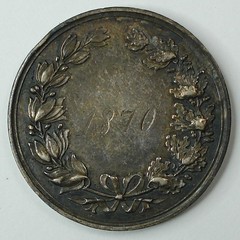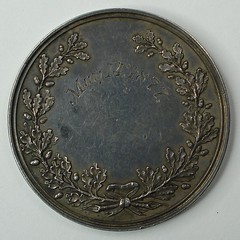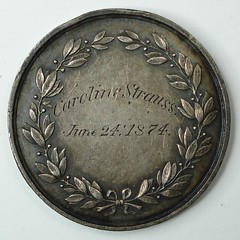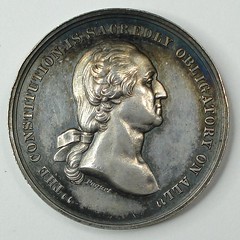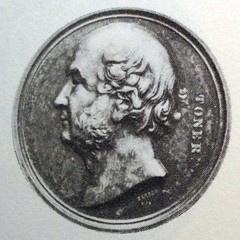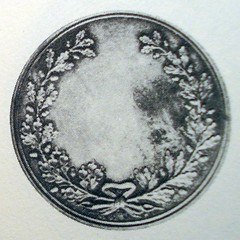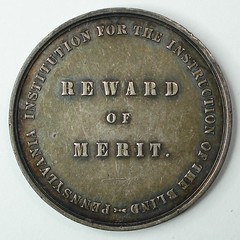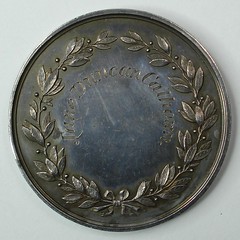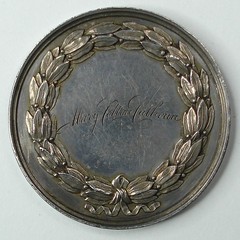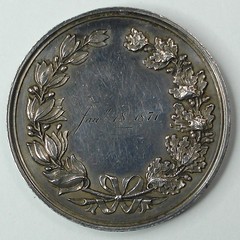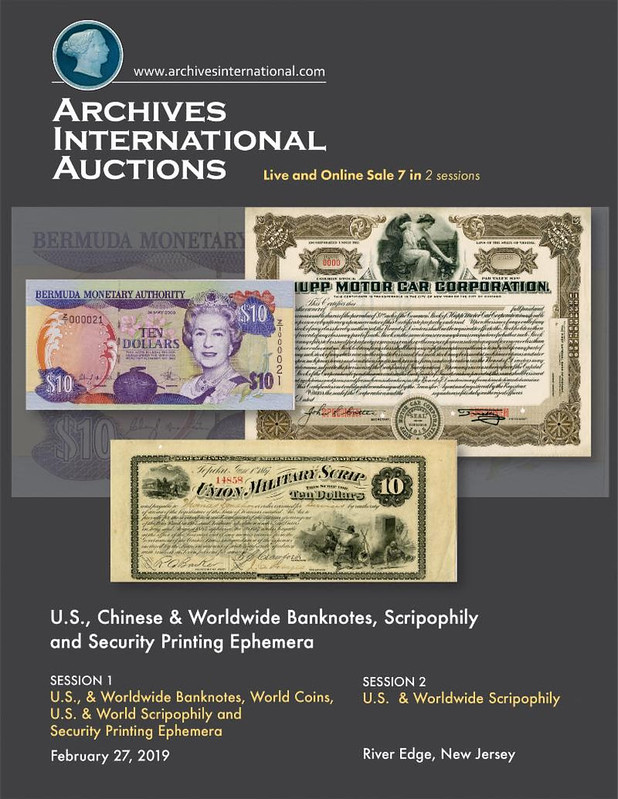
PREV ARTICLE
NEXT ARTICLE
FULL ISSUE
PREV FULL ISSUE
EXPERT-LEVEL U.S. MEDALS CHALLENGE RESULTSLast week Jonathan Brecher submitted a tough challenge for our readers. -Editor I think that anyone short of an expert will have a hard time answering more than one or two of these questions. But we've got some experts here! Let's see how folks do, or if I've come up with a stumper. :-) I'm showing the wreaths on the reverses of four different US medals. Three of these I've had for a while; the fourth one is a new purchase. And a jaw-dropper of a purchase also - but for reasons that are not exactly related to this challenge and that I'll reveal afterwards. For now, give this a shot: 1. Besides obvious trivial details (They're all round! They're all silver! They all have wreaths on them!), what do the four medals have in common? [difficult] 2. Identify each medal: Pete Smith writes: I have spent a couple of hours trying to identify the medals in Jonathan Brecher's challenge. So far I have been unsuccessful. Perhaps the thing they have in common is that they are all award medals that have no previously published photo. I started by looking through Julian, Medals of the United States Mint. An example is Julian SC-32, a 36 mm medal with reverse described as "Wreath around open field." I have not been able to find a photograph of the reverse. There are several other Julian medals of the correct size with a wreath reverse and no photograph. I suppose those could be called published, but they are impossible to identify. How is someone who does not own the medals supposed to make the identification? I haven't given up, but I have gotten frustrated. Pete's right to be frustrated - it takes a dedicated collector with his own handy-dandy reference collection to answer this one. -Editor John Sallay writes: The first medal (A) looks very familiar, but I just can place it. It will probably be doubly embarrassing for me once Jonathan confirms the answers to the challenge and I'm reminded that I have one in my collection, but just couldn't remember it. The other three are all U.S. Mint medals, and school award medals at that: B) Iowa State University, SC-26 C) Jefferson Medical College, SC-27 D) Pennsylvania Institution for the Instruction of the Blind, SC-32 My guess on the common thread is that Jonathan found them all on eBay and paid only a few dollars for each, even though they are all very rare, desirable, and valuable American medals. He's a collector's collector, absolutely amazing in what he is able to find! I can hardly wait to hear the jaw-dropping follow-up. On the PCGS Forum Daniel Carr writes: They all have a stepped rim, consistent with (but not limited to) 19th Century US Mint medals. OK - here are Jonathan's answers. -Editor I got a laugh out of Pete Smith's guess that these are all medals with no previously published photos. That would have been hilarious, at least for one of us! But no, at least two of these have been published, and Pete's instincts to look in Julian were spot on. Dan Carr's response is fascinating. I didn't notice that at all, and I'd never noticed that was a feature of US Mint medals. He got to the right answer that they're US Mint medals Kudos to school medal collector John Sallay for identifying three of the four medals. And the one he didn't identify wasn't a school medal, so it's understandable why he missed that one. All four of these are US Mint medals listed in Julian. In order, they are: Julian CM-3. The obverse of this medal is more commonly paired with a text-heavy reverse that features an Oath of Allegiance (CM-2). The wreath reverse is unpictured in Julian but several examples have been sold over the past few years. Julian SC-26, the Iowa State University award medal. This is a very, very rare medal. Julian could not find an example to picture in his book, knowing of it only from the mint records and a surviving obverse die. He writes, "There may be a reverse for this medal, as Irish paid $75 for the dies, which seems high for just one lettered die." Yes, there was a reverse! Julian SC-27, the Toner medal for Jefferson Medical College. This is pictured in Julian, where it listed as 32 mm. This is also a very rare medal, so much so that I don't have an example. I'm showing the pictures from Julian instead. The 1986 Dreyfuss sale included an example that confirms that the diameter is actually 36 mm and that the smaller size reported in Julian is incorrect. If you think it's odd that I can show you the reverse in the original challenge while also saying that I can't show you the obverse of the actual medal here… keep reading! Julian SC-32, the Pennsylvania Blind Institution award medal. This is another very, very rare medal. Julian has a photo of the obverse but not of the reverse. When I posed this challenge, I thought that someone might be able to identify CM-3. It's rare but not impossibly rare, and the wreath is fairly distinctive. From there, someone could realize that all of these have the "look" of US Mint medals of this period, and get a plate match to the photo of SC-27 in Julian. The other two (SC-26 and SC-32) are so rare and unpictured in Julian; it would have taken some doing for anyone to identify those without having examples of their own like John has. All of this brings us back to medal C. This was my recent purchase. I bought it online with one other piece, because it looked odd. I didn't think much about it when I bought it, or when I opened the package. Then I looked at it again. And I looked at the piece that came with it. And then I realized what I was looking at and my jaw hit the floor. (And then it took me 15 minutes to button everything down and confirm my hunch!) This is medal C again, on the left, and its flip side on the right. Look familiar? The piece I bought is a mule of the reverses of Julian SC-27 and SC-32. This is unlisted. As far as I know, it's also unprecedented. There are many mules known of the larger US Mint medals in the MI- and NA- series. Also, some of the obverse dies were intentionally struck with several different reverses, such as the series of dated medals for the Massachusetts Charitable Mechanics Association (Julian AM-34 through AM-41) with the same obverse and different reverses in different years. This may be the first example of a mule of two different small-size award medal dies originally intended for other US Mint medals, repurposed as a totally new award medal. This wasn't even on my radar as something that might possibly exist. The other piece I bought with this? It is of course a mule of the reverses of CM-3 and SC-26. Normally I'm skeptical when anyone claims to have found an unlisted US Mint medal. In this case, I'm calling it. We have four dies that are known to produce US Mint medals, and only known to produce US Mint medals, now seen in two pairs of struck mules. These have got to be legitimate (if clandestine!) US Mint medals as well. …and if you're still in doubt, there's the matter of the recipients. Medals of this type are normally called award medals, for the very obvious reason that they were normally awarded as prizes. It looks like my mules were also awarded, to Mary Colton Calhoun on January 18, 1871 and to Jane Duncan Calhoun on May 14, 1877. Appearances can be deceiving - those aren't award dates! Mary Colton Calhoun and Jane Duncan Calhoun were the second and third daughters of James Richardson Calhoun and Marie Louis Barth. Those are their BIRTH dates. The Calhouns lived in Philadelphia (huh!), specifically in the 10th district of the 3rd ward, which (of course!) is the ward that contained the US Mint building. In the 1870 census James Calhoun is listed as a clerk of the US Asst Treas. How about that! Now that was tough! Thanks, everyone. -Editor To read the earlier E-Sylum article, see: Wayne Homren, Editor The Numismatic Bibliomania Society is a non-profit organization promoting numismatic literature. See our web site at coinbooks.org. To submit items for publication in The E-Sylum, write to the Editor at this address: whomren@gmail.com To subscribe go to: https://my.binhost.com/lists/listinfo/esylum All Rights Reserved. NBS Home Page Contact the NBS webmaster 
|

